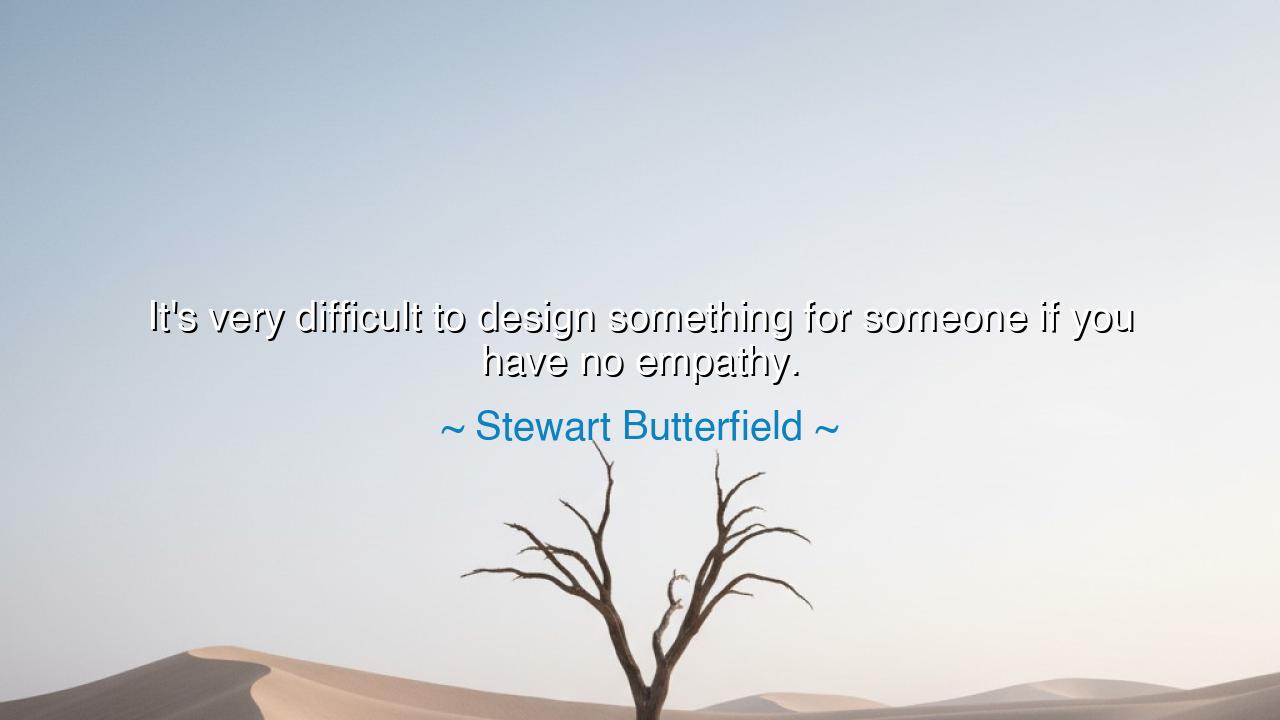
It's very difficult to design something for someone if you have






“It’s very difficult to design something for someone if you have no empathy.” – Stewart Butterfield
In these simple yet profound words, Stewart Butterfield, the creator of Slack and one of the visionaries of modern communication, touches upon a truth as old as creation itself — that empathy is the soul of design. His statement, though spoken in the context of technology and business, reaches far beyond the realm of invention. It speaks to the eternal bond between the maker and the one who is made for; between the creator and the created. To design without empathy is to build without love, to craft without purpose, to shape without soul. For what is design but the act of understanding another’s need — and giving it form?
The origin of this quote lies in Butterfield’s journey as both a designer and an entrepreneur. Before founding Slack, he had co-created Flickr — both tools born not from mere technical ambition, but from an understanding of how people communicate, connect, and share. In his words, Butterfield acknowledges that no tool, no product, no work of art can truly serve others unless its maker first learns to see through their eyes and feel through their hearts. The essence of his philosophy is this: that creation begins with compassion. Without it, even the most ingenious design becomes lifeless machinery, cold and unfeeling.
To understand his meaning, imagine the ancient craftsman — the potter shaping clay on his wheel. Before his hands even touch the earth, he imagines the family who will drink from that vessel, the mother who will carry water at dawn, the traveler who will sip from it under the stars. The potter’s art is guided by empathy — a silent dialogue between the maker and the unseen user. So it is, too, with every great architect, teacher, leader, or creator. To design well, whether it be a building, a bridge, or a human system, one must first listen deeply. One must step beyond the boundaries of self and dwell, if only for a moment, in the world of another.
History gives us many examples of this truth. Consider Florence Nightingale, the “Lady with the Lamp.” In the chaos of war, she designed the first modern hospital systems, not through engineering alone, but through empathy — by walking the halls of suffering, seeing what others ignored, and imagining what might heal both body and spirit. Her understanding of the wounded soldiers’ pain led her to reinvent not just medicine, but the very architecture of care. Or look to Leonardo da Vinci, who sketched machines of flight not from curiosity alone, but from a deep wonder at the human desire to soar. Empathy was the bridge between imagination and realization.
Butterfield’s insight also reveals the moral dimension of creation. In a world increasingly driven by algorithms and efficiency, he reminds us that true design is human. The designer who creates without empathy builds tools that alienate rather than connect, systems that exploit rather than empower. When governments, corporations, or inventors forget empathy, they forget the people they were meant to serve. Thus, design becomes domination, and progress becomes peril. To design with empathy, by contrast, is to honor the dignity of others, to shape not merely for profit, but for purpose — to make life easier, richer, more beautiful.
Yet, empathy is not weakness; it is strength refined by awareness. The leader who understands his people will rule with wisdom. The artist who feels the hearts of others will move the world. The engineer who listens to the frustrations of the user will build tools that endure. The truth that Butterfield speaks is thus both practical and spiritual: understanding precedes innovation, and feeling precedes form. The cold intellect may solve problems, but only the warm heart can create meaning.
So, my child of creation and conscience, take this teaching as both warning and blessing. When you make — whether it is a design, a decision, or a destiny — begin first with empathy. Listen before you plan. Observe before you act. Imagine before you command. Step into the shoes of those you serve, and let their needs shape your work. For only through compassion can creation become divine. A sword forged without care will wound its bearer; a tool forged with understanding will uplift all who touch it.
And thus, remember the words of Stewart Butterfield: “It’s very difficult to design something for someone if you have no empathy.” For empathy is the unseen blueprint of all that lasts. It is the melody that gives rhythm to invention, the light that guides the craftsman’s hand, the virtue that transforms knowledge into wisdom. To design with empathy is to love the world enough to make it better — and that, in the end, is the highest art of all.






AAdministratorAdministrator
Welcome, honored guests. Please leave a comment, we will respond soon